
FEDERAL BUREAU OF INVESTIGATION
Notes to Financial Statements
($ in thousands)
(1) Summary of Significant Accounting Policies
Basis of Presentation
These financial statements have been prepared to report the financial position and results of operations of the Federal Bureau of Investigation ("FBI" or "Bureau") as required by the Chief Financial Officers Act of 1990 and the Government Management Reform Act of 1994. They have been prepared from the books and records of the FBI in accordance with Office of Management and Budget (OMB) Bulletin 94-01, Form and Content of Agency Financial Statements, and the Bureau's accounting policies which are summarized in this note. These statements are therefore different from the financial reports, also prepared by the FBI pursuant to OMB directives, that are used to monitor and control the FBI's use of budgetary resources. The FBI received a waiver from OMB for preparing the 1996 Statement of Cash Flows and the Statement of Budgetary Resources and Actual Expenses.
Reporting Entity
The FBI, established in 1908, is an integral part of the Department of Justice. The FBI's mission is to uphold the law and investigate violations of Federal criminal law and to protect the United States from hostile intelligence efforts. The Bureau also provides assistance to other federal, state, and local law enforcement agencies as well as to the public at large. Assistance includes forensic services, training of law enforcement officials, background investigations, name checks, fingerprint analyses, and cooperative criminal investigations.
The FBI receives its funding from two primary sources: Congress and reimbursable activities. Congress appropriates funds on an annual basis which represent over 80 percent of the FBI's annual budget. Reimbursable activities comprise the remaining balance of the annual budget.
Basis of Accounting
Transactions are recorded on the accrual basis and are within budgetary limitations established to facilitate compliance with legal constraints and controls over use of federal funds. Under the accrual method, revenues are recognized when earned and expenses are recognized when a liability is incurred, without regard to receipt or payment of cash.
The General Accounting Office (GAO), OMB, and Department of the Treasury (Treasury) established the Federal Accounting Standards Advisory Board (FASAB) for the purpose of considering and recommending accounting principles, standards, and requirements to GAO, Treasury, and OMB. The three principals of FASAB, the Comptroller General, the Secretary of the Treasury, and the Director of OMB, decide on new principles, standards, and requirements after considering FASAB's recommendations. The resulting standards are concurrently issued by GAO and OMB. Pending issuance and effective date of a sufficiently comprehensive set of accounting standards, and in accordance with the interim guidance agreed to by the three principals, the accompanying financial statements have been prepared in accordance with the following hierarchy of accounting principles and standards:
· individual standards agreed to and published by the Joint Financial Management Improvement Program (JFMIP) Principals, (GAO, OMB, and Treasury), based upon recommendations from FASAB;
· form and content requirements included in OMB Bulletin 94-01, dated November 16, 1993, and subsequent issuances;
· FBI accounting policies summarized in this note; and,
· accounting principles published by authoritative standard setting bodies and other authoritative sources (1) in the absence of such other guidance in the first three parts of this hierarchy, and (2) if the use of such accounting standards improves the meaningfulness of the financial statements.
Revenue and Other Financing Sources
The FBI receives the majority of its funding needed to support operations through congressional appropriations. The FBI receives annual, multi-year, and no-year appropriations that may be expended within statutory limits for operating and capital expenditures. Additional amounts are obtained through reimbursement for services provided to other federal agencies and to the public.
Appropriations are recognized when the related expenditures are incurred. Revenue for reimbursable services is recognized when the services are performed.
Other revenue and financing sources consist of amounts received from the sale of assets and personal property.
Fund Balance with Treasury and Cash
The U.S. Treasury processes cash receipts and disbursements of the FBI. The funds with the U.S. Treasury include: appropriated funds that are available to pay current liabilities and finance authorized purchase commitments; and deposit and clearing accounts. In addition to Treasury fund balances, a cash balance is maintained primarily to support imprest fund payments.
Accounts Receivable
Accounts receivable are established from federal, state, and local government agencies for reimbursable and appropriated activities. An allowance for uncollectible accounts receivable is not established based on favorable historical accounts receivable loss experience.
Advances and Prepayments
Advances represent money advanced for confidential, travel, or commercial activities. The related expense is recognized when the activity occurs and the transactions are reported.
Operating Materials and Supplies
The general composition of operating materials and supplies is made up of ammunition, gas and oil, and office supplies. The items included in the year end balance are located at the FBI Academy at Quantico and at the Headquarters warehouse. The FBI reports the inventory at cost using the first-in first-out method.
Property and Equipment
The FBI leases its headquarters building, field office buildings, and warehouse space from the General Services Administration (GSA). The FBI also leases office space from the State Department and non-governmental entities. In addition, the FBI owns land and buildings.
The FBI is currently constructing the Criminal Justice Information Services Center in Clarksburg, West Virginia. Construction costs of the Center are capitalized as construction-in-progress. When these assets are placed in service, they will be reclassified as appropriate, and depreciated in accordance with FBI procedures.
Property and equipment is stated at cost less accumulated depreciation. The FBI capitalizes property and equipment purchases with a cost greater than $25,000 and useful lives of more than one year. Expenditures for other property acquired and for repairs and maintenance are charged to operating expenses as incurred. Depreciation is calculated on the straight line basis over the estimated useful lives of the assets.
Liabilities
Liabilities represent amounts owed by the FBI as the result of transactions or events that have occurred as of year end. Liabilities for which Congress has not appropriated funds are classified as liabilities not covered by budgetary resources.
Seized Assets
The FBI accounts for Seized Assets in accordance with Statement of Federal Financial Accounting Standards Number 3, "Accounting for Inventory and Related Property." Seized monetary assets are reported at their estimated fair market value at the date of seizure on the accompanying statement of financial position with an offsetting liability included in governmental liabilities not covered by budgetary resources. Seized nonmonetary assets are not reflected on the statement of financial position but are disclosed at their estimated fair value at the date of seizure in the notes to the financial statements.
Assets are considered seized when the FBI takes possession of the items. Disposition actions include returning the property to the owner or obtaining a court action forfeiting the property to the Department of Justice or another government agency. If an asset is encumbered by lien, the asset may be sold to satisfy the lien, or the asset is turned over to the lienholder. Assets not encumbered by liens are either sold, donated to other state and local enforcement agencies, retained by the FBI for use in future operations, or destroyed.
The estimated fair value of seized nonmonetary assets is determined dependent on the type of asset. Common mass-produced items such as automobiles and certain equipment, are valued at estimated fair value at time of seizure using third-party reference guides. Unique items such as land, homes, jewelry, art, etc. are valued using expert appraisers.
Accrued Unfunded Annual Leave
Annual leave is accrued as a liability as it is earned. The accrual is reduced as leave is taken. Each year, the balance in the accrued annual leave account is adjusted to reflect current year pay rates. Because current or prior year appropriations are not available to fund annual leave earned but not taken, funding will be obtained from future appropriations. Sick leave and other types of nonvested leave are charged to expense as the leave is used.
Accrued Workers' Compensation
The Federal Employees' Compensation Act (FECA) provides income and medical cost protection to covered Federal civilian employees injured on the job, employees who have incurred a work-related occupational disease, and beneficiaries of employees whose death is attributable to a job-related injury or occupational disease. Claims incurred for benefits for FBI employees under FECA are administered by the Department of Labor (DOL) and are ultimately paid by the FBI. The workers' compensation liability has two components, (1) unpaid billings, and (2) an amount of estimated unbilled claims. The unbilled claims are estimated using actuarial techniques. The DOL calculated the liability of the Federal Government for future compensation benefits, which includes the expected liability for death, disability, medical, and miscellaneous costs for approved compensation costs. The liability was determined using the paid-losses extrapolation method calculated over the next 23-year period. This method utilizes historical benefit payment patterns related to a specific incurred period to predict the ultimate payments related to that period. The projected annual benefit payments were discounted to present value. The resulting Federal Government liability was then distributed by agency. The compensation benefits liability constitutes an extended estimate of cost which will not be obligated against budgetary resources until the year in which the cost is actually billed to the DOJ and allocated to the FBI.
Retirement Plan
On January 1, 1987, the Federal Employees Retirement System (FERS) became effective pursuant to the Federal Employees' Retirement System Act of 1996. Most employees hired after December 31, 1983, are automatically covered by FERS and Social Security. Employees hired prior to January 1, 1984, elect to either join FERS and Social Security or remain in the Civil Service Retirement System (CSRS).
For employees covered by the CSRS, the FBI contributes 7 percent of the employee's gross pay for normal retirement or 7.5 percent for hazardous duty retirement. For employees covered by the FERS, the FBI contributes approximately 13 percent. All employees are eligible to contribute to the Federal Thrift Savings Plan (TSP). For those employees covered by the FERS, a TSP account is automatically established, and the FBI is required to contribute an additional 1 percent of gross pay to this plan and match employee contributions up to 4 percent. No matching contributions are made to the TSP accounts established by the CSRS employees.
The FBI's total contributions for CSRS and FERS participants during the year ended September 30, 1996, were $49,567 and $112,655, respectively.
The FBI's financial statements do not report CSRS or FERS assets, accumulated plan benefits, or unfunded liabilities, if any, which may be applicable to FBI employees. Such reporting is the responsibility of the Office of Personnel Management.
Net Position Accounts
Net position account balances consist of the following components:
Unexpended appropriations
Represent amounts of spending authority that are unobligated, or obligated but not expended, and available to the FBI.
Invested capital
Represents (1) the FBI's cost of property and equipment acquired that has been financed by appropriations less the reduction in investment due to depreciation, plus (2) the unexpended balance of operating materials and supplies.
Future funding requirements
Future funding requirements represent the amount of appropriated funding that will be needed in future periods to liquidate liabilities incurred through the current fiscal year. Funding for these items is generally received in the year that amounts become due and payable.
Displays and Archives
The FBI has a display area at FBI Headquarters in Washington, D.C. and maintains archives at this location as well. The display area and archives contain a weapons collection of over 5,000 handguns, rifles, and shotguns; precious metals, jewelry, and other seized assets; and other artifacts relating to the FBI's operations. These items are not included in the accompanying financial statements.
Custodial records are maintained for all weapons, precious metals, jewelry, seized assets, and other valuable artifacts on display. Physical inspections are performed annually to ensure accountability for these items.
Comparative Data
Comparative data for the prior year are not presented since this is the first year the FBI has prepared financial statements in accordance with OMB Bulletin 94-01.
(2) Fund Balances with Treasury
Fund Balances with Treasury represent the FBI's undisbursed budgetary authority as of September 30, 1996, as follows:

Obligated amounts consist of undelivered orders and orders received but unpaid. The
balance of $(1,696) represents non-entity assets in deposit and suspense clearing
accounts.
(3) Accounts Receivable
Intragovernmental Accounts Receivable consist of reimbursements and repayments due from other federal agencies. The repayments represent amounts due for salaries and other expenses incurred by FBI employees on behalf of those agencies. At September 30, 1996, the FBI recognized $199,910 in intragovernmental accounts receivable.
At September 30, 1996, the FBI recognized $16,330 in governmental accounts receivable. This account represents amounts due from nonfederal governmental sources for goods provided and services rendered.
(4) Cash and Other Monetary Assets
Cash and Other Monetary Assets represent cash resources under the control of the FBI, which may include coin, paper currency, purchased foreign currency, negotiable instruments, and amounts on deposit in banks and other financial institutions. Cash available for agency use includes petty cash, emergency funds, and imprest funds. At September 30, 1996, cash and other monetary assets included $12,186 in entity assets and $7,766 in non-entity assets.
(5) Property and Equipment, Net
Property and equipment and related accumulated depreciation at September 30, 1996, consisted of:

N/A = not applicable
SL = straight line
(6) Seized Property
Information regarding the balance of seized property for the period is as follows:
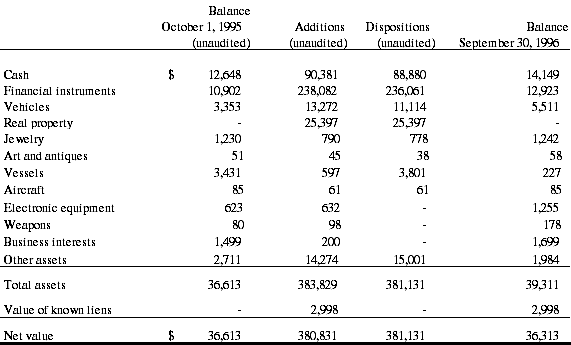
Only cash and financial instruments as of September 30, 1996, totaling $27,072, have been reported on the statement of financial position.
Information regarding the number of seized property items held during the period is as follows (unaudited) (the cash number in certain cases represents the number of bank accounts seized):
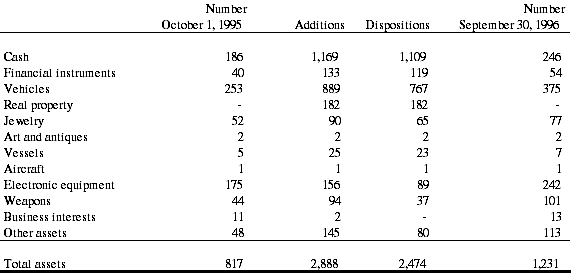
(7) Capital Leases
The FBI's capital lease obligations at September 30, 1996 follow:
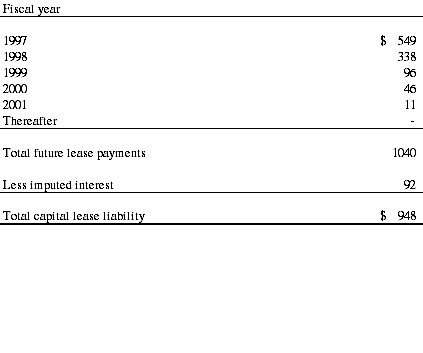
(8) Net Position
The net position of the FBI as of September 30, 1996, was made up of the following components.
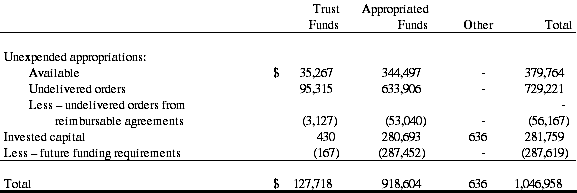
Future funding requirements represent expenses incurred that will be paid by future appropriations. The following is a summary of future funding requirements as of September 30, 1996.
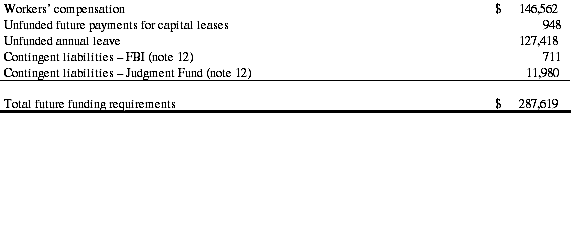
(9) Operating Leases
The FBI leases various facilities and equipment under operating leases. Assets held under these leases consist of offices, parking facilities, warehouses, aircraft hangars, office equipment, and vehicles.
The majority of space occupied by the FBI is leased by the General Services Administration (GSA). The space is assigned based on the FBI's square footage requirements. The rent charged by GSA is based on approximate commercial rates for commercial space. The FBI may terminate the leases at any time without incurring termination charges. However, it is anticipated that the FBI will continue to occupy and lease space from GSA in future years. Lease expense paid during fiscal year 1996 totaled $200 million. The FBI does not expect cash expenditures for rent to change significantly in future periods.
The following is a summary of remaining lease payments related to lessors other than GSA
under existing operating lease terms ranging from 1 to 5 years and thereafter:

(10) Adjustments (Unaudited)
Adjustments affecting the beginning balance of net position include the following items:

(11) Nonoperating Changes (Unaudited)
Changes in net position arising from other than the excess of expenses over revenue and financing sources consisted of the following items for the year ended September 30, 1996:

Nonoperating changes include a decrease of $13,391 of unexpended appropriations and a corresponding increase to appropriated capital used to fund prior period expenses.
(12) Contingencies
The FBI is a defendant in various administrative proceedings, legal actions, and claims. Settlements in tort cases under $2.5 are paid from FBI appropriations, and amounts in excess of $2.5 are eligible to be paid by the U.S. Treasury Judgment Fund. Judgments and attorneys fees in other types of cases may also be paid from FBI appropriations. The FBI's Office of General Counsel has determined that possible awards relating to adverse decisions and settlements under statutes and regulations should not exceed $4,140 at September 30, 1996, which would not materially affect the financial position or results of operations of the FBI. The probable judgments against the FBI, in the amount of $12,691 have been recorded in Other Governmental Liabilities Not Covered by Budgetary Resources. The Office of General Counsel is not aware of any significant threatened or unasserted claims against the FBI as of September 30, 1996.
#####